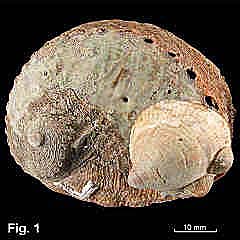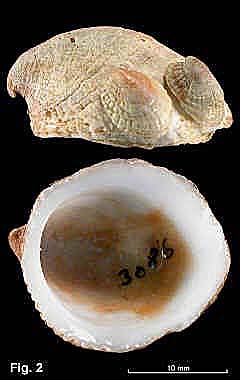|
|
|
|
|
Hipponix australis (Lamarck, 1819) Description: Shell limpet-shaped, variable in height, apex near or overlapping rear margin. Sculptured with axial ribs and irregular concentric growth lines. Margin irregular, conforming to substrate surface, crenulate within. Interior with horseshoe shaped muscle scar, open anteriorly. Exterior colour fawn with white apex, interior white or tan. Size: Up to 30 mm in length, commonly 5-15 mm. Distribution: In southern Australia, from Twofold Bay, NSW, around southern Australia to southern WA, including Tasmania. Habitat: Lives on the shells of other molluscs, at low tide level and in the shallow sub-tidal. Synonymy: In Australian literature this species has usually been referred to as Hipponix conicus (Schumacher, 1817). Knudsen (1991) points out that the taxonomy of the genus is chaotic, and that the names Hipponix australis (Lamarck, 1819) and Hipponix conicus (Schumacher, 1817) have been used indiscriminately for at least four species from the Indo-West Pacific and southern Australia. I am following Knudsens's recommendation that H. australis be used for the southern Australian species. Remarks: This species was studied in South Australia by Laws (1971) and at Princes Royal Harbour, south-western WA, by Knudsen (1991). Knudsen reported on the shell, radula, external anatomy, reproduction and habitat. Simone (2002) described the anatomy of animals from Woodman Point, south-western WA, and Maria Island, Tasmania. Knudsen found the species lives on a wide variety of large and small gastropods, including Fusinus, Turbo, Campanile and even Nassarius. It erodes a site on the host shell, and the foot secretes a callus in the scar, in large specimens forming a domed pad. There may be one or dozens of individuals on each host shell, frequently growing on top of each other, in more or less fixed positions, often with small males on larger females. It probably feeds by grasping loose sediment which is suspended by water movement, and utilizes the organic matter suspended in it. It is a protandrous consecutive hermaphrodite ( i.e, male first, then female). Females brood egg capsules of embryos which hatch as crawling juveniles. Laws found that in South Australia and Tasmania it lives mainly on abalones, where it moves with the growth of the host to maintain a position just behind the lip (Fig. 1). The position beside the abalone's water current outlet holes suggests it is feeding on the abalone's fecal pellets. The fact that Knudsen reported shells to be stationary and Laws reported they reposition with growth of the host suggests they were not studying the same species. The anatomy of this species is described by Simone (2002) (as Sabia conica). Fig. 1: Port Latta, Tasmania. Two small males on a larger female, on an abalone (DLB3086) Fig. 2: Same specimens as Fig. 1 |

